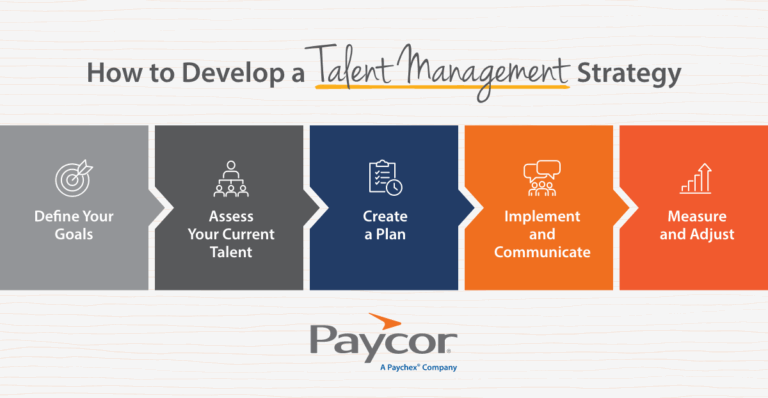Are you considering expanding your business? To do so you’ll need to lean into your most valuable asset: your people. Developing a well-defined talent management strategy, which is essential for success, should be on the top of your to-do list.
This article will walk you through the key steps to developing a robust strategy that aligns with your business goals and helps you manage talent effectively.
What is a Talent Management Strategy?
A talent management strategy is exactly what it sounds like: a robust plan that helps businesses effectively manage talent to achieve business and employee growth. In essence, it’s a framework that connects your people processes. It involves using various approaches to attract, develop, and retain employees who contribute to the company’s success.
Why is Talent Management Strategy Important?
An effective talent management strategy can help to:
- Improve employee performance: Companies can enhance the skills and productivity of their workforce by focusing on development and engagement. In fact, businesses with highly engaged workforces are 24% more profitable (Gallup).
- Boost retention: A strong strategy helps retain top talent by providing opportunities for growth and recognition. Is the business challenged by turnover that negatively impacts costs? Research shows that 94% of employees would stay at a business longer if it invested in their professional development (LinkedIn).
- Achieve business goals: By aligning talent initiatives with business objectives, businesses can ensure their workforce is equipped to meet future challenges and opportunities.
How to Develop a Talent Management Strategy

Developing a talent management strategy involves a series of steps that HR leaders and business owners can follow. For each step, it’s important to consider your specific business needs and goals.
Define Your Goals
Clearly identify what you want to achieve with talent management. Are you trying to fill skill gaps, improve employee retention, or enhance leadership development?
Assess Your Current Talent
Evaluate what skills and strengths your workforce possesses, as well as any areas of development that exist. With this knowledge, you’ll be better able to identify where your strategy needs to focus.
Create a Plan
When developing your comprehensive plan, make sure it includes outlines on specific actions, timelines, and responsibilities for each aspect of your strategy. These aspects could include recruitment, onboarding, training, and performance management.
Implement and Communicate
Share your plan and make sure everyone understands the new strategy. Walk employees through the benefits and what it could mean for their own growth and career opportunities. Remember to invite feedback — giving people a chance to voice concerns or ideas will help everyone feel more invested in the change.
Measure and Adjust
Your talent management plan will only work by establishing continuous tracking of key metrics such as turnover rates, employee engagement scores, and performance data. To make your strategy more effective, be prepared to implement adjustments as needed.
5 Effective Talent Management Strategies to Incorporate
Here are a handful of effective strategies to consider for your talent management plan:
1. Use Integrated Talent Management
Connect every aspect of the employee lifecycle, from recruiting and hiring to learning, development, and performance management. When these functions work together, employees experience a smoother journey at your company. For example, the skills and goals identified during recruitment should directly inform training opportunities and performance reviews. This kind of integration not only boosts employee engagement but also makes it easier for managers to spot and develop high-potential talent.
2. Create Employee Onboarding Programs
A well-designed onboarding process is about more than just paperwork and orientation sessions. It’s your chance to help new hires understand your company culture, build relationships, and get up to speed on their roles. Structured onboarding gives employees the tools and knowledge they need to perform well from day one, leading to higher retention and faster productivity. Consider pairing new hires with mentors, setting clear milestones for their first months, and providing feedback early and often.
3. Provide Career Management and Development Opportunities
LinkedIn’s Workplace Learning Report found that 84% of employees agree that learning adds purpose to their work and is that career development is a key driver for company growth and employee retention.
4. Develop Succession Planning
Business continuity is more readily ensured when a business Identifies and prepares future leaders within the organization. Improving people managers’ skills tops the priority list for HR leaders in all 16 industries and 17 geographies surveyed, according to a Global Talent Trends Report by Mercer.
5. Provide Compensation and Recognition
Go beyond basic compensation planning by ensuring your pay structure is fair, competitive, and transparent. Consider both salary and additional incentives such as bonuses, stock options, or profit sharing to reward outstanding work. Pair these tangible rewards with a thoughtful recognition program that highlights individual and team achievements, making employees feel valued and motivated to sustain high performance.
Real-life Talent Management Strategy Examples
See how companies are getting real results with Paycor’s talent management software. These examples show the positive impact our solutions have made, helping organizations put their strategies into action and drive meaningful change.
- Geon Performance Solutions used Paycor’s talent development tools to create clear career paths, attract and nurture new talent, and implement a continuous feedback system that aligned employee growth with company goals.
- Premier Parks used Paycor’s integrated platform and mobile tools to streamline seasonal hiring and learning processes, making it easier to recruit, onboard, and empower employees—especially their large, mobile seasonal workforce.
- Olberding Brand Family uses Paycor’s learning management tools—including a flexible Course Builder—to create engaging training content and foster continuous employee learning and development, all while streamlining HR and talent processes.
Developing Your Talent Management Strategy with Paycor
Paycor’s suite of HCM software solutions supports every stage of your talent management strategy. These solutions include:
- Talent management tools for overseeing the entire employee lifecycle.
- Talent development software to foster employee growth.
- Career management software that enables employees to shape their own career paths.
- Learning Paths for building structured courses that develop key skills and competencies.
- Compensation planning tools to ensure fair and competitive pay within your industry.
Create a Talent Management Strategy with Paycor
Ready to transform your talent management? Take a guided tour to see how Paycor can help you build and implement a winning talent strategy for your business.









